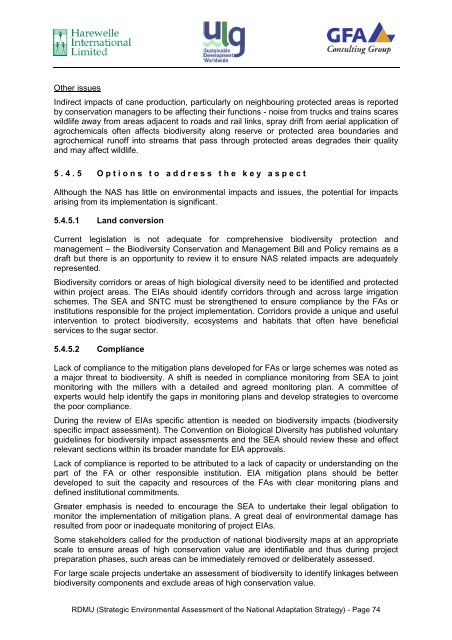Service Contract No 2007 / 147-446 Strategic ... - Swaziland
Service Contract No 2007 / 147-446 Strategic ... - Swaziland
Service Contract No 2007 / 147-446 Strategic ... - Swaziland
- No tags were found...
Create successful ePaper yourself
Turn your PDF publications into a flip-book with our unique Google optimized e-Paper software.
Other issuesIndirect impacts of cane production, particularly on neighbouring protected areas is reportedby conservation managers to be affecting their functions - noise from trucks and trains scareswildlife away from areas adjacent to roads and rail links, spray drift from aerial application ofagrochemicals often affects biodiversity along reserve or protected area boundaries andagrochemical runoff into streams that pass through protected areas degrades their qualityand may affect wildlife.5.4.5 Options to address the key aspectAlthough the NAS has little on environmental impacts and issues, the potential for impactsarising from its implementation is significant.5.4.5.1 Land conversionCurrent legislation is not adequate for comprehensive biodiversity protection andmanagement – the Biodiversity Conservation and Management Bill and Policy remains as adraft but there is an opportunity to review it to ensure NAS related impacts are adequatelyrepresented.Biodiversity corridors or areas of high biological diversity need to be identified and protectedwithin project areas. The EIAs should identify corridors through and across large irrigationschemes. The SEA and SNTC must be strengthened to ensure compliance by the FAs orinstitutions responsible for the project implementation. Corridors provide a unique and usefulintervention to protect biodiversity, ecosystems and habitats that often have beneficialservices to the sugar sector.5.4.5.2 ComplianceLack of compliance to the mitigation plans developed for FAs or large schemes was noted asa major threat to biodiversity. A shift is needed in compliance monitoring from SEA to jointmonitoring with the millers with a detailed and agreed monitoring plan. A committee ofexperts would help identify the gaps in monitoring plans and develop strategies to overcomethe poor compliance.During the review of EIAs specific attention is needed on biodiversity impacts (biodiversityspecific impact assessment). The Convention on Biological Diversity has published voluntaryguidelines for biodiversity impact assessments and the SEA should review these and effectrelevant sections within its broader mandate for EIA approvals.Lack of compliance is reported to be attributed to a lack of capacity or understanding on thepart of the FA or other responsible institution. EIA mitigation plans should be betterdeveloped to suit the capacity and resources of the FAs with clear monitoring plans anddefined institutional commitments.Greater emphasis is needed to encourage the SEA to undertake their legal obligation tomonitor the implementation of mitigation plans. A great deal of environmental damage hasresulted from poor or inadequate monitoring of project EIAs.Some stakeholders called for the production of national biodiversity maps at an appropriatescale to ensure areas of high conservation value are identifiable and thus during projectpreparation phases, such areas can be immediately removed or deliberately assessed.For large scale projects undertake an assessment of biodiversity to identify linkages betweenbiodiversity components and exclude areas of high conservation value.RDMU (<strong>Strategic</strong> Environmental Assessment of the National Adaptation Strategy) - Page 74
















